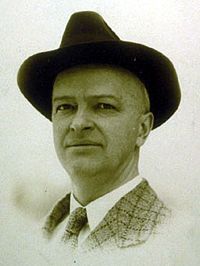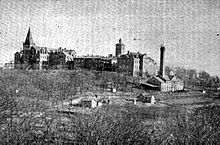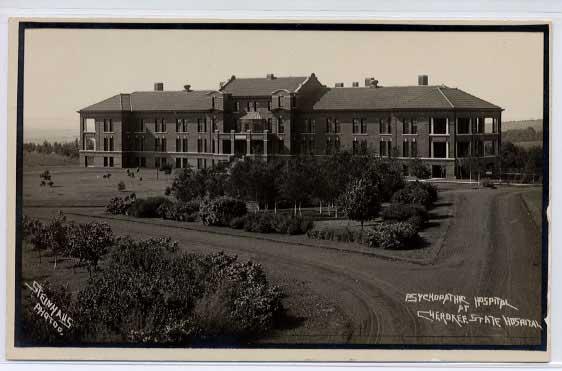Iowa
Number of victims
1,910
persons were
sterilized. More than two thirds of them were females. An about equal
number of
those sterilized were considered mentally ill or mentally deficient,
but
slightly more than 5% were neither (Paul, p. 362).
Period during which sterilizations occurred
The
period spans from the
1910s to 1963. The majority of sterilizations
occurred between 1948-1952 in which 746 total operations were performed (Paul, p. 359; Lind, p. 112).
Temporal pattern of sterilizations and rate of sterilization

The
number of sterilizations
in Iowa remained relatively low until the late 1930s and then began to
increase
in the 1940s. The period with the highest number sterilizations was
1940 to
1955, after which time the number of sterilizations decreased. In 1949 165 total sterilzation operations took place, the most procedures done in a single year. (Lind, p. 112). The peak
rate of
sterilizations occurred in the late 1940s and early 1950s, when on
average 150
people were sterilized each year (Paul, p. 362). The rate of
sterilization per
100,000 residents per year for this period was about 6.
Passage of laws
Iowa was the ninth state to pass a sterilization law in the United States (Laughlin, p. 1). The first law was enacted in 1911 by the thirty-fourth General Assembly, and allowed for the directors of the mental institutions and members of the state board of parole to determine whether or not an inmate ought to be sterilized (Laughlin, p. 21).This law was soon repealed and replaced by a second law, enacted in 1913 (Laughlin, p. 22).
Groups identified in the law
The
first law, dated July 4, 1911, applied to “criminals,
idiots, feeble-minded, imbeciles, lunatics, drunkards, drug fiends,
epileptics,
syphilitics, etc.” moral and sexual perverts, and diseased and
degenerate
persons” (Laughlin, pp. 21, 22). It was compulsory for those “inmates
twice
convicted of a felony, or sex-offense other than ‘white slavery.’” For
the
offense of “white slavery,” one conviction made sterilization mandatory
(Laughlin, p. 9). Despite
the intent to
diminish these groups’ influence on society, criminals were not
actually
sterilized (Paul, p. 359), as the third law eliminated criminals from
the list
of persons subject to the operation (Laughlin, p. 9). Also, epilepsy
was
apparently a sole reason for sterilization (Paul, p. 364 n. 3). As
Julius Paul
notes, the law applied extramurally, and there was a significant number
of
sterilizations on non-institutionalized persons (Paul, p. 360). After
the State
Eugenics Board was created (see below), it included “feeble-minded,
insane,
syphilitic, habitual criminals, moral degenerates, or sexual perverts
and who
are a menace to society” and might produce children likely to become “a
social
menace of ward of the state” (Vogel, p. 128).
Process of the law
To
apply Iowa’s first eugenics law of
1911,
the managing officers of the institutions had the duty to determine by
examination whether or not the mental and/or physical conditions of the
inmates
made them unfit to procreate. The
institutions’
surgical superintendents and the members of the state board of parole
were also
consulted. If the
group decided that the
offspring of an inmate would be a likely victim of “disease, crime,
insanity,
feeble-mindedness, idiocy or imbecility,” then the inmate would undergo
an
operation of vasectomy or ligation of the Fallopian tubes (Laughlin, p.
21). After
the second law had been passed in 1913 and subsequently found
unconstitutional,
the third sterilization law of Iowa required the written consent of the
patient
or close relative before the operation could be completed. It also eliminated the
application of the
operation to criminals (Laughlin, p. 9).
The
Eugenics movement in Iowa saw an important change
in 1929, as the State Eugenics Board was created. The Commissioner of
Public
Health was on this board, as were the medical director of the
Psychopathic
Hospital in Iowa City, and the superintendents of the four state
hospitals for
the insane (Cherokee, Clarinda, Independence, and Mount Pleasant), of
the Women’s
Reformatory at Rockwell City, of the Hospital for Epileptics and
Feebleminded
at Woodward, and the Institution for Feebleminded Children at Glenwood.
The
people who ran different state institutions were instructed to report
candidates for sterilization to the Board. The Board then briefly
reviewed the
case and decided the fate of the inmate. Consequently, close to two
thousand
people were sterilized under the authority of the State Eugenics Board until it was abolished in 1977
(Vogel,
p. 128).
Precipitating factors and processes
The
pre-World War II era saw “concern
with controlling the effects of procreation among socially dependent
classes of
people” (Vogel, p. 120). During
this
time, the ideas of Harry Laughlin became a significant precipitating
factor of
the eugenics movement, as he influenced the creation of groups of
philanthropists and women who advocated for the Iowan’s philosophies
(Vogel, p.
123). Iowa’s creation of the Board of Eugenics in 1929 also was a
factor that
increased sterilizations in the state, as they “authorized the
sterilization of
more than two thousand men and women in Iowa” (Vogel, p. 128).
Even
though eugenics decreased as a
national movement after World War II, sterilization in Iowa actually
increased,
at least in part due to the activities of Birthright and the Human
Betterment
League. Although national organizations, they became popular in Iowa
after the
war as the organization emphasized the “voluntary” aspect of
sterilization and
its alleged utility as a method of contraception for people with mental
disabilities, making the process appear less cruel (Vogel, p. 134). The
Iowa
chapter of the Human Betterment League was established in the 1940s and
worked
to spread the approval of sterilizations by educating the public on the
topic. They
strategically explained the
“need” for this process to nurses, lawyers, college students and
ministers, as
these groups of educated individuals would likely understand the
“positive”
outcomes of the law. The
Human
Betterment League popularized the movement through such tactics as
setting up
mass mailings, holding press releases and handing out biased,
informative
brochures to the public. For example, an 18-page brochure urged the
public to
approve of and understand the Iowa sterilization law as a positive way
to
improve society. It
contained images and
descriptions of the ways that the law would protect handicapped
individuals and
the community alike (Vogel, pp. 134-136). The efforts of the
organization,
which also served as “an ‘unofficial auxiliary’ to the State Board of
Eugenics,
were successful, as one of the highest numbers of sterilizations
occurred
during the early 1940s, the time period during which the League was at
work
(Vogel, pp. 135, 137-138),
Groups targeted and victimized
The
groups who were targeted and
victimized by the eugenics movement were people with inadequate
heredity and “socially
ineffective members of the community” (Laughlin, p. 455). The members behind the
sterilization movement
also sought to eliminate poverty, and thus believed poor people ought
to be
targets of the operation (Vogel, p. 133). Although criminals and
epileptics
were targeted in the law, no information about the actual sterilization
of
these people exists (Paul, pp. 359, 364).
In fact, it appears that only people with mental
retardation or mental
illness were sterilized (Paul, p. 359).
Other restrictions placed on those identified in the law or with disabilities in general
The
groups of people identified in the
Iowa sterilization laws “were the target[s] of proposals for marriage
restrictions, permanent custody, and sexual sterilization.” However, sexual
sterilization was thought to
be the most productive method for creating a “better” human race, so
the other
two ideas were never carried out (Vogel, p. 123).
Major proponents
 (Photo courtesy of Wikipedia, available at <http://en.wikipedia.org/wiki/Harry_H._Laughlin)
(Photo courtesy of Wikipedia, available at <http://en.wikipedia.org/wiki/Harry_H._Laughlin)
Beyond
the Iowa chapter of the Human
Betterment League, eugenics in Iowa received support from a major
national
figure. Arguably Iowa’s main “contribution” to the national eugenics
movement
came in the person of Harry H. Laughlin, who was born in Oskaloosa,
Iowa, in
1880. After
attending schools in his
home state, Laughlin became interested in heredity, evolution and
genetics. He was
significantly
influenced by Dr. Charles Davenport, the first person to expose the
citizens of
the United States to Mendelian genetics.
Laughlin became the superintendent of the Eugenics Record
Office and
published numerous works on eugenics that became influential to his
fellow Iowa
citizens. Iowa was
among the many states
that followed Laughlin’s
ideas for sterilization laws, as described in Eugenical
Sterilization in the United States.
Harry Laughlin also conducted research on
immigration, eventually proposing that such people were inferior to the
rest of
society. “He
also
was a member of the Galton Society, the Eugenics Research Association,
the
American Society of International Law, the American Statistical
Associate,
president of the American Eugenics Society 1927-28,
associate editor of the Eugenical
News from 1916 to 1939,
secretary of the Third International Congress of Eugenics in 1932, and
president of the Pioneer Fund, Incorporated, from its origin until
1941” (Pickler
State Library). Due
to his extensive
research and work with eugenics, Harry Laughlin is considered to be the
“principal force behind the passage of sterilization laws around the
country,
including Iowa” (Vogel, p. 123). In 1939, when the Eugenics Records
Office in
Cold Springs Harbor, New York (see state of New York) closed, he
returned to
Iowa, where he resided until his death. Perhaps ironically, he
discovered that
he suffered from epilepsy—among the very conditions he sought people to
be
sterilized for.
“Feeder institutions” and institutions where sterilization were performed
Some of the following information is based on Laughlin’s list of early
sterilizations
performed in Iowa (pp. 65, 143) and on the information concerning
institutions
whose directors and superintendents reported to the State Eugenics
Board. The rest of the information was obtained from various other sources (cited below).
 (Photo courtesy of Wikipedia, available at http://en.wikipedia.org/wiki/Glenwood_Resource_Center)
(Photo courtesy of Wikipedia, available at http://en.wikipedia.org/wiki/Glenwood_Resource_Center)
 (Photo courtesy of Kirkbridge Buildings, available at http://www.kirkbridebuildings.com/blog/tag/Iowa)
(Photo courtesy of Kirkbridge Buildings, available at http://www.kirkbridebuildings.com/blog/tag/Iowa)
The Hospital for Epileptics and Feebleminded was at Woodward.
The Women’s Reformatory at Rockwell City was a women’s prison until 1982 and is now a correctional facility.
 (Photo courtesy of TheGazette, available at http://thegazette.com/tag/fort-madison/)
(Photo courtesy of TheGazette, available at http://thegazette.com/tag/fort-madison/)
Fort Madison State Penitentiary (Laughlin, p. 143) is located at Avenue
E & 1st Street in Fort Madison, Iowa and is currently used as a maximum security
prison for men. It also offers vocational training, substance abuse help, and
basic education classes (Iowa Department of Corrections).
 (Photo courtesy of Kirkbridge buildings, available at http://www.kirkbridebuildings.com/buildings/independence/)
(Photo courtesy of Kirkbridge buildings, available at http://www.kirkbridebuildings.com/buildings/independence/)
 (Photo courtesy of RootsWeb, available at http://freepages.geneology.rootsweb.ancestry.com/~kneen/Cherokee/cherokee.html)
(Photo courtesy of RootsWeb, available at http://freepages.geneology.rootsweb.ancestry.com/~kneen/Cherokee/cherokee.html)
Cherokee Hospital for the Insane
The
Cherokee Hospital for the Insane opened its doors to patients in
1902 under the name of the Iowa Lunatic Asylum to Cherokee with Dr.
Nelson Voldeng as its first elected superintendent (Wikipedia). It is
infamous as the site in which hundreds of lobotomy surgeries on “feeble
minded” patients were performed. It reached peak occupancy of about
1,700 patients in the mid 1940’s. Today Cherokee operates under the
Iowa Department of Human Services and provides inpatient and
outpatient care to adults, adolescents and children in 41 counties
across the state. The south wing of the institution serves as a prison
for the criminally insane (Wikipedia). Most patients committed to the
facility are admitted
on a court order. (Waddington).
 (Photo courtesy of RootsWeb, available at <http://www.rootsweb.ancestry.com/~asylums/mtpleasant_ia/index.html)
(Photo courtesy of RootsWeb, available at <http://www.rootsweb.ancestry.com/~asylums/mtpleasant_ia/index.html)
The
Mount Pleasant
State Hospital, originally known as the Iowa Lunatic Asylum was the
location
for a small number of early sterilizations. The facility was
constructed in 1855 and opened its doors to patients in 1861
(Wikipedia).A fire destroyed much of
the
building in 1936, and therefore little of the institution remains today
(Kirkbridge, “Mount Pleasant Hospital”).
However, part of the building is used today as a male
correctional
facility that offers programs for sex offenders and people with
substance abuse disorders
(Iowa Department of Corrections).
Often,
institutionalized children (in multiple facilities) suffered highly
disturbing institutional abuse and inhumane treatment. Children were
placed in unhygienic conditions, endured physical abuse and
punishments, were not properly administered their required medications,
and suffered from overall neglect. Additonaly, many children with no
apparent disabilities or deficiencies were wrongfully, and forcibly
confined within these institutions for many years. (Lind ch. 5). For
example, Woodward Hospital was notorious for its poor patient care. The
institution frequently engaged in the practice of pulling patient’s
teeth to inhibit inappropriate biting, and failed to provide patients
with necessities such as adequate food, clothing or recreational time.
Cases of similar of violent abuse have been reported in other
institutions as well (Lind, p. 85).
According to Iowa law after 1915, sterilization of all persons required
voluntary consent. Often times this law was manipulated through
coersion; patients were told they would only be released from an
institution and placed on parole upon consenting to surgical
sterilization. Only then would patients agree to the procedure as a
means to escape the confines of the institution (Lind, p. 110).
Opposition
Laughlin’s
ideas were challenged specifically in Iowa by the Woman’s Christian
Temperance
Union (WCTU), whose members collected a grant for the Iowa Child
Welfare
Research Station. The
purpose of the
grant was to carry out such tasks as the examination of the impact of
the
environment and heredity on child development, as proof that IQ
increased from
birth to death emerged. This
evidence
suggested that the potential of children should therefore not be
violated, as
simple nurturing could improve a child’s mental capacity (Vogel, pp.
126,
130). Opposition
also came from the
families of the victims, who were permitted to refuse the operation. Unfortunately, this
opposition was often not
brought to the attention of the boards, as it would threaten the
victim’s
chances of being allowed to leave his or her institution and return
home
(Vogel, pp. 130, 131). The
members of
the Catholic Church also expressed their opposition to sterilizations,
and
their actions caused several proposed cases to be dismissed (Vogel, p.
139).
Bibliography
Bezanson, Randall P. 2003. Story 7: What is the Public’s Business? How Free Can the Press Be? Illinois: The Board of Trustees of the University of Illinois.Iowa Department of Corrections. 2002. “Institution Descriptions.” Available at <http://www.doc.state.ia.us/InstitutionDesc.asp>.
Iowa History Project. “History of Medicine in Iowa”. Available at <http://iagenweb.org/history/Medicine/asylums.htm>Kirkbride
Buildings.
“Cherokee State Hospital.” Available at <http://www.kirkbridebuildings.com/buildings/cherokee/>.
Kirkbride
Buildings.
“Clarinda State Hospital.” Available at <http://www.kirkbridebuildings.com/buildings/clarinda/>.
Kirkbride
Buildings.
“Independence State Hospital.” Available at <
http://www.kirkbridebuildings.com/buildings/independence/>.
Kirkbride
Buildings.
“Mount Pleasant State Hospital.” Available at < http://www.kirkbridebuildings.com/buildings/mountpleasant/>.
Landman,
J. H. 1932. Human
Sterilization: The History of the Sexual Sterilization Movement.
New York: MacMillan.
Laughlin, Harry H. 1922. Eugenical Sterilization in the United States. Chicago: Municipal Court of Chicago.
Lind, Linda Sue Impecoven. 2000. "The Forgotten Child: The History of
Special Education in Iowa. Have We Really Come As Far As We
Think?" Thesis (M.S)—Iowa State University.
Medical
Museum,
University of Iowa Hospitals and Clinics. “Diagnostik: Exhibition
Brochure.”
Available at < http://www.uihealthcare.com/depts/medmuseum/galleryexhibits/diagnostik/brochure.html>.
Pickler
Memorial
Library, Truman State University. 2008. “Harry H. Laughlin.” Available at <http://library.truman.edu/manuscripts/laughlinbio.htm>.
Vogel,
Amy. 1995,
“Regulating Degeneracy: Eugenic Sterilization in Iowa, 1911-1977.” Annals of Iowa 52, 2: 119–43.
Waddington, Lynda. "At a glance: Iowa's four historic mental health institutions". Available at http://iowaindependent.com/19481/at-a-glance-iowas-four-historic-mental-health-institutions.
Wikipedia. "Cherokee Mental Health Insitute". Available at http://en.wikipedia.org/wiki/Cherokee_Mental_Health_Institute
Wikipedia. "Clarinda Treatment Complex". Available at http://en.wikipedia.org/wiki/Clarinda_Treatment_Complex
Wikipedia. “Glenwood Resource Center” Available at http://en.wikipedia.org/wiki/Glenwood_Resource_Center
Wikipedia. “Iowa Institution for Feeble-Minded Children.” Available at < http://en.wikipedia.org/wiki/Iowa_Institution_for_Feeble-Minded_Children>.
Wikipedia. "Mount Pleasant Mental Health Insitute". Available at http://en.wikipedia.org/wiki/Mount_Pleasant_Mental_Health_Institute.